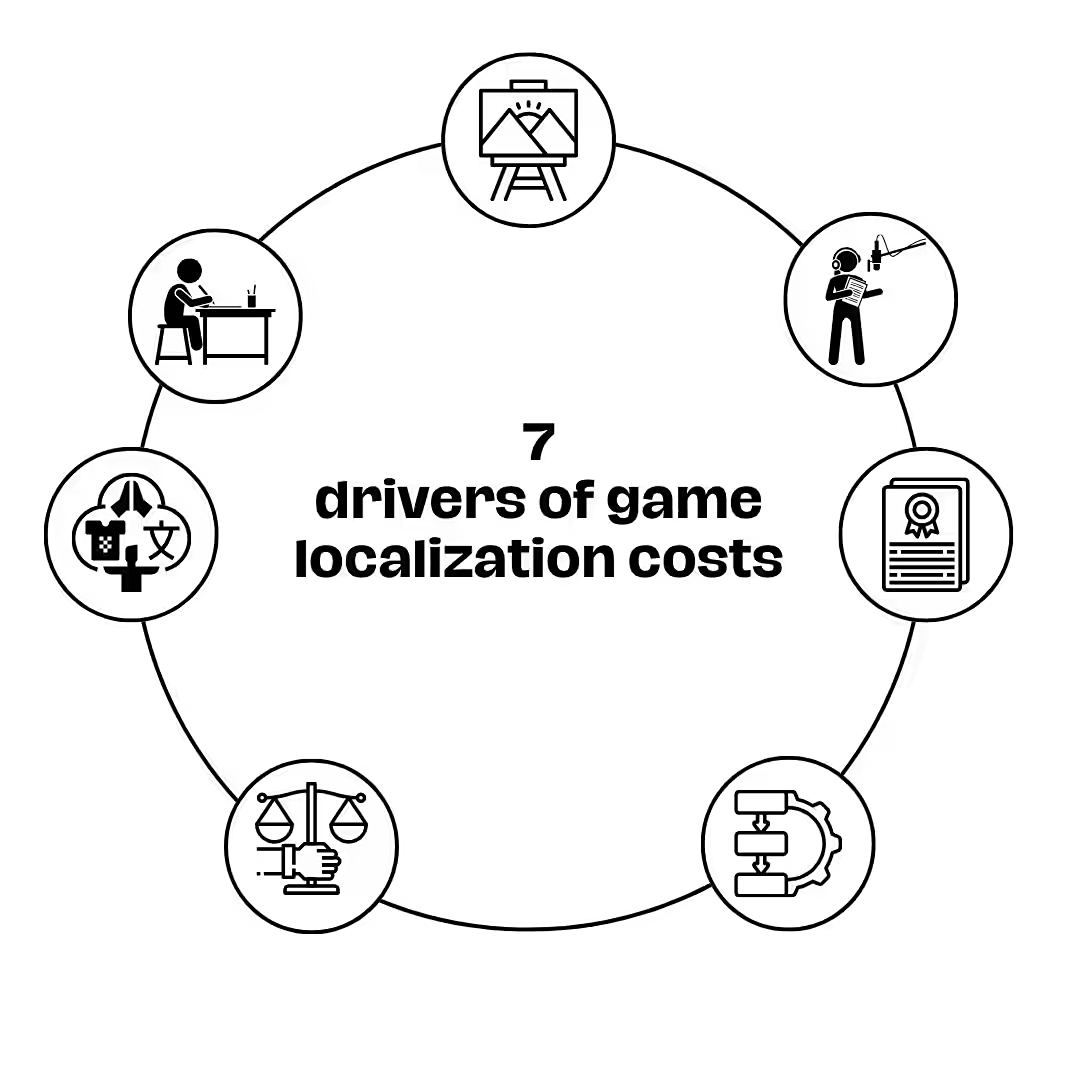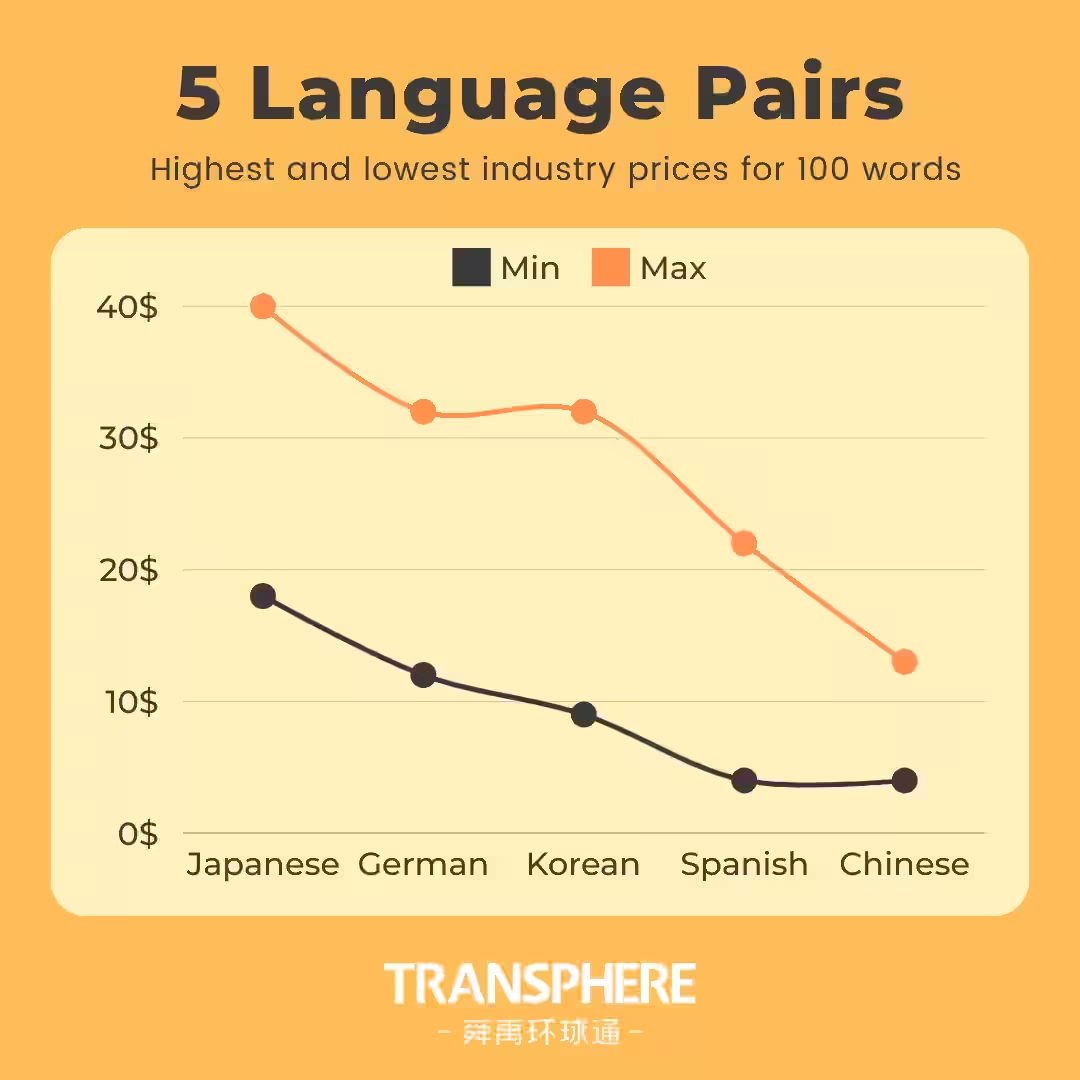Understanding game localization costs is crucial for any developer looking to expand their reach. To get you started, we’d like to give you a quick estimate: you can expect the average game to cost around $28,000 to localize into a single language.
But this is just a (very) rough estimate—the final price tag will vary based on several factors unique to your project. From the type of game you are producing (story-driven RPGs vs roguelikes) to the quality requirements you have.
In this guide, we’ll delve into those factors and explain why it’s difficult to pinpoint a precise estimate without knowing the specifics of your game. Our goal is to give you a clearer picture of what goes into game localization pricing so you can budget accordingly.
Understanding the components of game localization costs
As we touched on previously, there’s a whole bunch of factors that can make your game localization costs swing up or down. A lot boils down to what kind of game you’re making.
A classic platformer like Super Mario, where the story takes a backseat, will be way quicker (and cheaper) to localize. You might only need to translate menu options and some basic instructions.
On the flip side, if you’re building the next epic RPG, something with the scope of The Witcher 3 or Baldur’s Gate 3. Suddenly, your localization needs grow exponentially. You’ll have to handle tons of dialogue, branching storylines, endless quests, and complex lore, both in-game and beyond… not to mention voice acting. Naturally, the price for localizing a game like that will be way higher.
Translation: At the heart of localization lies the translation and adaptation of in-game text, dialogue, and other content into the target language(s).
It involves more than just word-for-word translation; it requires cultural adaptation to ensure the game resonates with diverse audiences worldwide.Our software localization translation price is designed to offer a balance of quality and affordability, ensuring that your game meets the cultural and linguistic expectations of your target markets at a competitive cost.
But it doesn’t stop here. Several translation factors can drive costs one way or the other. Here’s a breakdown of the key players:
- Language popularity: Widely spoken languages like English or Chinese have a larger pool of available translators, generally leading to lower costs. Finding qualified linguists might be more expensive due to a smaller talent pool for less common languages.
- Machine vs. human: Machine translation offers a cheaper option, but the results can be awkward and miss the mark, especially for creative content. Human translation comes at a premium but ensures your game’s humor and impact land smoothly.
- Creative content vs. technical text: Menus and basic instructions might be okay with a more straightforward translation approach. However, for story-driven games with heavy dialogue and cultural references, human adaptation is essential to capture the full experience in the new language.
Art and Graphic Localization: Visual elements such as graphics, artwork, and user interface design play a crucial role in localization. Adapting these components to accommodate different languages and cultural preferences requires skilled design work and may involve additional production costs.
Just how much visual adaptation is needed varies wildly. Let’s break it down:
-
Text in images: Does your game have signs, posters, or instructions baked into the artwork? Those need to change! It can be as simple as editing a file or as complex as hiring an artist for a full redraw.
-
Cultural sensitivities: Some graphics might be totally fine in one place and completely inappropriate in another. Think about religious symbols, and hand gestures… seemingly small things can have big implications. For instance, when World of Warcraft: The Wrath of the Lich King expanded into China, they faced strict rules about showing things like bones and gore. It means a substantial redesign of undead areas, a costly change considering the expansion is undead-heavy!

- Finding the right voices: Good voice actors match their characters both in sound and skill. Finding the right voice in a new language can be challenging. That’s even more so the case if you intend to use local celebrities for extra buzz.
- Studio time: Recording isn’t just about the actors. We’ll need to book studio space and sound engineers to get quality audio. And the more attempts there are between the perfect recording session or not, the more the costs can increase.
- Script adaptation: Direct word-for-word translation often sounds stiff. As such, scripts may need to be entirely rewritten, at least in part, to flow naturally in the new language.
- Lip-sync: While not always a top priority, for understandable reasons, lip-synching can enhance the immersion of a scene. But due to how labor-intensive it is, it is often only done in one language or a few key ones. Still, it remains a potential factor that can affect your audio localization costs.
Testing and Quality Assurance: Localization testing is essential to identify and rectify linguistic or functional issues before release. Testers fluent in the target language(s) meticulously assess the game’s interface and content to ensure a seamless worldwide gaming experience.
Project Management: Coordinating the complex game localization process requires effective project management. From liaising with translators and voice actors; communicating with developers and designers; to overseeing quality control efforts, skilled project management is indispensable for timely and successful localization.
Legal and Regulatory Compliance: Expanding into new markets involves navigating diverse legal and regulatory landscapes. From content regulations to compliance requirements, localizing a game requires ensuring it adheres to local laws and regulations.
Cultural Consultation: Respecting cultural norms and sensitivities is paramount in game localization. Engaging cultural experts or advisors ensures that the localized content aligns with the cultural expectations of diverse audiences.
📌In this guide we won’t cover marketing and distribution costs as they are not usually part of localization.
Calculating game localization costs: A step-by-step approach
Now that we’ve explored the various factors affecting the cost of game localization, we can break down how to calculate these expenses.
Let’s assume you are building an incredible game named “Transphere Chronicles,” and you intend to distribute it to gamers from 6 different markets with 6 different languages. Well, you’ll have to go through 5 major localization stages.
1. Translation
The translation stage has two main steps: figuring out the content that requires translation and then getting actual price quotes.
Step 1: The word count
First things first, count all the text that needs translating. That includes dialogue, quests, menus, help sections, and anything players will read! Let’s say your game, “Transphere Chronicles,” has 50,000 words in total.
Step 2: The quotes
Now it’s time to contact translation companies. You need to get a quote for each language on a per-word basis. For our example, let’s say you negotiate a rate of $0.17 per word and language.
| Word Count | Price Per Word | Languages | Total Cost |
|---|---|---|---|
| $50,000 | $0.17 | 6 | $51,000 |
Keep in mind that this is a simplified example. Real-life pricing is more complex, and factors like those we discussed earlier will heavily impact the final price tag. And each language pair will have a different price per word.
Check the table below for a detailed outlook on 5 popular language pairs:

2. Art and Graphic Localization
The process for figuring out your visual localization costs is similar to translation: first, count the assets, then get quotes.
Let’s imagine “Transphere Chronicles” has 200 visual elements needing changes (signs, posters, character models, etc.), and you negotiate a rate of $10 per asset with a graphic designer or localization specialist. Here’s a quick breakdown:
| Assets | Cost Per Asset | Languages | Total Cost |
|---|---|---|---|
| 200 | $10 | 6 | $12,000 |
3. Voiceover and Audio Localization
📌 Productivity (how many screens they can check per hour) depends on the complexity of your game. Dense, text-heavy games will take longer!
For “Transphere Chronicles,” let’s assume it has a total of 500 lines of dialogue, you negotiate a voiceover rate of $15 per line, and editing/adaptation comes to an estimated $500.
| Lines | Rate Per Line | Additional Fees | Languages | Total Cost |
|---|---|---|---|---|
| 500 | $15 | $500 | 6 | $48,000 |
Remember, voiceover costs are highly variable. Actor experience, studio rates, script complexity, and the need for lip-syncing can all push that price tag up or down.
Furthermore, while incredible strides in AI-powered voice-over technology (i.e., ElevenLabs) can help reduce costs for some cases, their suitability remains limited to specific characters, and can’t be used across the entire project.
4. Testing and Quality Assurance
Testing is slightly more complex since it has three major components: test case preparation, linguistic testing, and functional testing.
Test case preparation
Before testers can get to work, they need a detailed test case. It needs to be created by someone with both testing expertise and a deep understanding of your game. For a moderately complex game, expect around 16 hours of work by a senior localization testing engineer.
| Hourly Rate | Total Hours | Total Cost |
|---|---|---|
| $60 | 16 | $960 |
On the bright side, a test case is typically a one-time cost.
Linguistic testing
To assess these costs, you’ll need to estimate the time needed. It is usually based on the number of “screens” (menus, dialogue sections, etc.) linguists need to review. Then, you’ll need an hourly rate and productivity estimate from your translation partner.
Let’s say your game, “Transphere Chronicles,” has 500 screens for testing. Your partner quotes you $30 per hour, and estimates their linguists can review 10 screens per hour:
| Screens | Hourly Productivity | Work Hours Required | Hourly Rate | Languages | Total Cost |
|---|---|---|---|---|---|
| 500 | 10 screens/hour | 50 | $30 | 6 | $9,000 |
📌
Functional testing
Estimate your functional testing costs based on your usual internal testing costs of the source language. Since functional testing in other languages is less in-depth, expect it to be around 30% cheaper per language.
Let’s say your internal testing usually costs $5,000. For a localized version, the functional testing might then cost roughly $3500.
This is a very rough guideline. If your game is heavily reliant on mechanics that change based on language (like text size affecting puzzle solutions), your functional testing costs might be higher.
| Lines | Rate Per Line | Additional Fees | Languages | Total Cost |
|---|---|---|---|---|
| 500 | $15 | $500 | 6 | $48,000 |
5. Management and Consulting
For the remaining 3 factors, Project Management, Cultural Consultation, and Regulatory Compliance, the costs can vary a lot from project to project. As you can imagine, a Spanish-to-Italian adaptation will be simpler than a launch in a region with strict content rules.
As a ballpark figure, these extra costs will add up to around 20% of your other localization expenses. But remember, this is just an average! So, let’s recap those core localization costs:
| Translation | Graphics | Voice Acting | Testing & QA | Total So Far | Management & Consulting Cost |
|---|---|---|---|---|---|
| $51,000 | $12,000 | $48,000 | $30,960 | $141,960 | $28,392 |
So, as you can see in the table above, 20% of $141,960 is $28,392. That’s the final Management & Consulting cost.
The final game localization cost
The final localization cost is $28,392 per language. And in this case, it’s $170,352 for all 6 languages. But, and we cannot emphasize this enough, this final number should be taken with a grain of salt.
The numbers provided in this guide are for illustrative purposes only. Your costs could end up higher or lower, depending on all those factors we discussed. The main takeaway isn’t the exact dollar amount. It’s understanding all the pieces that go into that final price tag.
The only way to get a truly reliable estimate is to reach out to a reputable game localization company and get a personalized quote.
